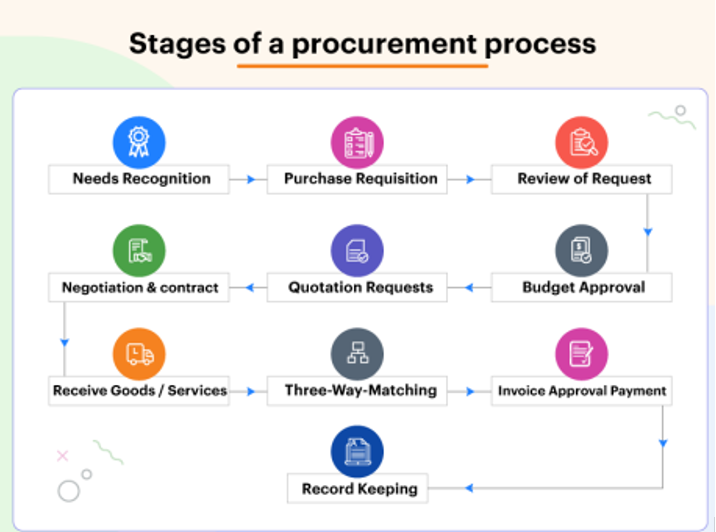Our Values: Professionalism, efficiency, precision and integrity
A E-Procurement management also known as Procure to Pay, is the process of requisitioning, ordering and purchasing goods and services online. It is a business-to-business process. Unlike e-commerce, e-procurement utilizes a supplier's closed system and is only available to registered users E-procurement establishes a direct link, enhancing communication between a company and its suppliers. This platform facilitates various interactions, including bids, purchase orders, and emails.
E-procurement systems provide comprehensive supplier management tools, allowing organizations to: Maintain a Supplier Database: Store and manage supplier profiles, including contact details, contract terms, certifications, and performance metrics. Evaluate and Select Suppliers: Use automated tools to evaluate suppliers based on predefined criteria like cost, quality, delivery times, and reliability. Supplier Onboarding: Simplify the process of adding new suppliers to the system with automated verification and registration workflows.
E-Procurement enables an automated and paperless purchase requisition process. Employees can: Create Purchase Requests: Submit requests for goods or services digitally, specifying product details, quantities, and delivery timelines. Approval Workflows: Route requisitions through predefined approval hierarchies for management review, ensuring that purchases meet organizational policies and budgets. Track Requests: Monitor the status of requisitions in real-time, from submission to final approval.
Once requisitions are approved, e-procurement systems automatically generate Purchase Orders (POs). Key features include: Automated PO Creation: Convert approved requisitions into POs without manual intervention, reducing errors and processing time. PO Dispatch: Send POs electronically to suppliers, ensuring timely communication. Order Tracking: Track the progress of the order, from supplier confirmation to delivery, providing visibility into the procurement cycle.
E-Procurement supports electronic tendering and RFx processes to invite bids or proposals from suppliers. This feature enables: RFx Creation: Draft and publish requests for proposals (RFP), requests for quotes (RFQ), or requests for information (RFI) to multiple suppliers simultaneously. Bid Submission: Suppliers can submit their bids electronically, ensuring faster and more secure responses. Bid Evaluation: Compare supplier responses and select the best offer based on pre-defined criteria, including pricing, quality, and service.
E-Procurement platforms provide tools for creating, storing, and managing contracts with suppliers: Automated Contract Creation: Generate contracts based on templates or previous agreements, reducing legal and administrative work. Contract Compliance: Ensure purchases align with contract terms, such as pricing and delivery schedules. Contract Renewals & Expiry Alerts: Receive notifications when contracts are nearing expiry or require renewal.

At Outsourced Professional Services,we understand the complexities of procurement. Our Procure to Pay system is designed to integrate seamlessly with your existing workflows, providing a user-friendly interface and robust functionality. With our expertise, you can transform your procurement process, enhance supplier relationships, and achieve operational excellence. We help you improve compliance and control among suppliers, contracts, regulations, buyers, and accounts payable by digitizing your procurement process.
E-Procurement automates time-consuming manual processes, such as purchase requisition, approval workflows, and invoice processing. This reduces delays, eliminates paperwork, and allows procurement teams to focus on more strategic tasks.
By improving procurement processes, organizations can benefit from: Better Supplier Negotiations: Through the use of e-tendering and competitive bidding, buyers can negotiate better prices and terms with suppliers. Reduced Administrative Costs: Automation reduces the need for manual labor and paperwork, leading to lower administrative expenses. Spend Control: E-Procurement systems provide visibility into organizational spending, helping to prevent over-ordering or purchasing outside of pre-approved vendor lists.
E-Procurement provides a full audit trail of procurement activities, from supplier selection to payment. This level of transparency helps in: Fraud Prevention: Ensures compliance with procurement policies and reduces the risk of fraudulent transactions. Accountability: Tracks who authorized purchases and who made procurement decisions, creating accountability within the organization.
By maintaining a digital record of supplier interactions, contracts, and performance data, organizations can: Foster Better Supplier Collaboration: Open communication channels and integrated systems make it easier to collaborate with suppliers. Evaluate Supplier Performance: Use performance data to identify top-performing suppliers and eliminate underperformers.
E-Procurement platforms help ensure that all purchasing activities comply with internal policies, industry standards, and regulatory requirements. The system tracks certifications, contract terms, and purchase histories to avoid non-compliance risks.
is a procurement process where any interested and qualified supplier can submit a bid to provide the required goods or services. Key Features: Open to all suppliers, promoting transparency and competition. Usually advertised publicly to attract a wide range of potential suppliers. Commonly used in government or public sector procurements.
is a procurement method where only a select number of suppliers are invited to submit bids. Unlike open tendering, it limits competition to pre-qualified suppliers. Key Features: Only qualified or invited suppliers can participate. Generally used when the buyer has a preferred list of suppliers or when specialized goods/services are needed.
A Request for Proposals (RFP) is a formal document that outlines a project or need and asks suppliers to submit detailed proposals on how they would meet the requirements. Key Features: Focuses on a supplier’s ability to provide a solution, rather than just the price. Often used for complex projects where different approaches may be considered.
In Two-Stage Tendering, suppliers are first invited to submit an initial proposal based on limited information. In the second stage, selected suppliers are invited to submit more detailed bids. Key Features: The first stage focuses on qualifications, while the second stage involves detailed pricing and technical proposals. Commonly used for large, complex projects where full details are not available upfront.
A Request for Quotations (RFQ) is a formal request to suppliers to submit their price for supplying a defined set of goods or services. It is usually used for simpler, more standardized purchases. Key Feature: Focuses on pricing, with minimal emphasis on technical or qualitative aspects. Typically used when the product or service is well-defined and requires no customization.